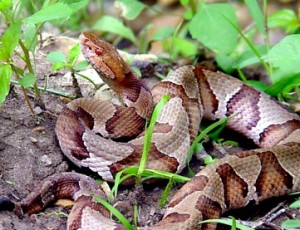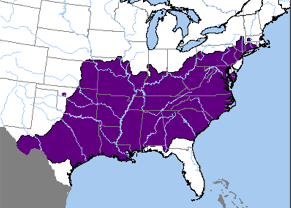
Copperhead
So do you want the good news or bad news first? Okay, so the good news about these snakes is they have the least potent venom of the North American pit vipers, and they’re distribution is limited.
The bad news… these snakes are responsible for more bites than any other US species. You might say they have a tendency to bite when they feel threatened, as opposed to rattling their tails or showing their fangs.
 To the right is a map of the Copperhead’s range. They tend to live in wooded areas, rocky creek banks, and in wood piles.
To the right is a map of the Copperhead’s range. They tend to live in wooded areas, rocky creek banks, and in wood piles.
RELATED: Watch this Beheaded Copperhead Bite Itself! [VIDEO]
The basic physical description of this snake is a pit viper with a striking cross-banded color pattern that usually has copper tones to it. There are several subspecies with varying colorations, but all species have a similar pattern, almost like a camouflage.
The base tone tends to be pale tan to almost a pinkish tan, with the dark brown “hourglass” pattern repeating from nose to tail.
